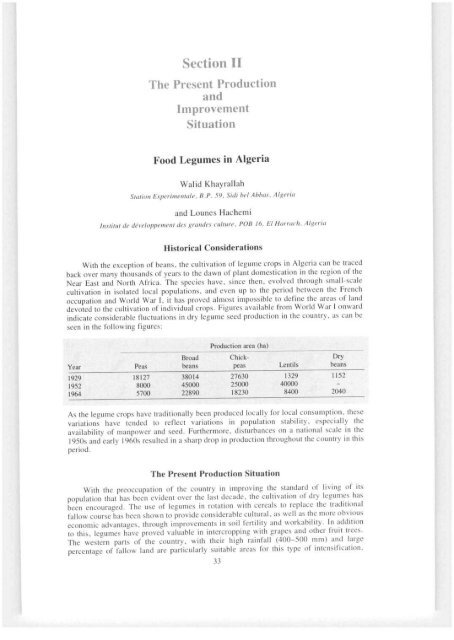I ARCHIV - International Development Research Centre
I ARCHIV - International Development Research Centre
I ARCHIV - International Development Research Centre
- No tags were found...
Create successful ePaper yourself
Turn your PDF publications into a flip-book with our unique Google optimized e-Paper software.
Section II<br />
The Present Production<br />
and<br />
Improvement<br />
Situation<br />
Food Legumes in Algeria<br />
Walid Khayrallah<br />
Station Experitnentale, B.P. 59, Sidi hel Abbas, Algeria<br />
and Lounes Hachemi<br />
Institut de développement des grandes culture, POB 16, El Harrach, Algeria<br />
Historical Considerations<br />
With the exception of beans, the cultivation of legume crops in Algeria can be traced<br />
back over many thousands of years to the dawn of plant domestication in the region of the<br />
Near East and North Africa. The species have, since then, evolved through small-scale<br />
cultivation in isolated local populations, and even up to the period between the French<br />
occupation and World War I, it has proved almost impossible to define the areas of land<br />
devoted to the cultivation of individual crops. Figures available from World War I onward<br />
indicate considerable fluctuations in dry legume seed production in the country, as can be<br />
seen in the following figures:<br />
Production area (ha)<br />
Broad Chick- Dry<br />
Year Peas beans peas Lentils beans<br />
1929 18127 38014 27630 1329 1152<br />
1952 8000 45000 25000 40000<br />
1964 5700 22890 18230 8400 2040<br />
As the legume crops have traditionally been produced locally for local consumption, these<br />
variations have tended to reflect variations in population stability, especially the<br />
availability of manpower and seed. Furthermore, disturbances on a national scale in the<br />
l950s and early l960s resulted in a sharp drop in production throughout the country in this<br />
period.<br />
The Present Production Situation<br />
With the preoccupation of the country in improving the standard of living of its<br />
population that has been evident over the last decade, the cultivation of dry legumes has<br />
been encouraged. The use of legumes in rotation with cereals to replace the traditional<br />
fallow course has been shown to provide considerable cultural, as well as the more obvious<br />
economic advantages, through improvements in soil fertility and workability. In addition<br />
to this, legumes have proved valuable in intercropping with grapes and other fruit trees.<br />
The western parts of the country, with their high rainfall (400-500 mm) and large<br />
percentage of fallow land are particularly suitable areas for this type of intensification.<br />
33

















